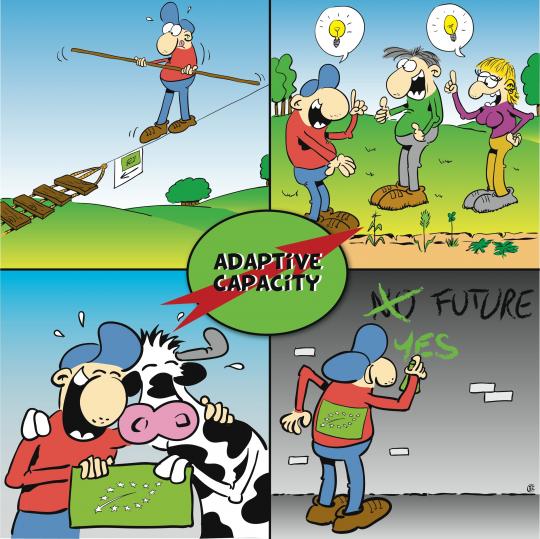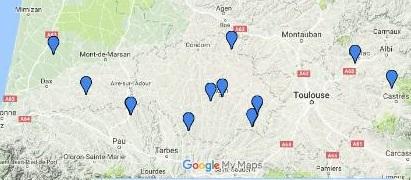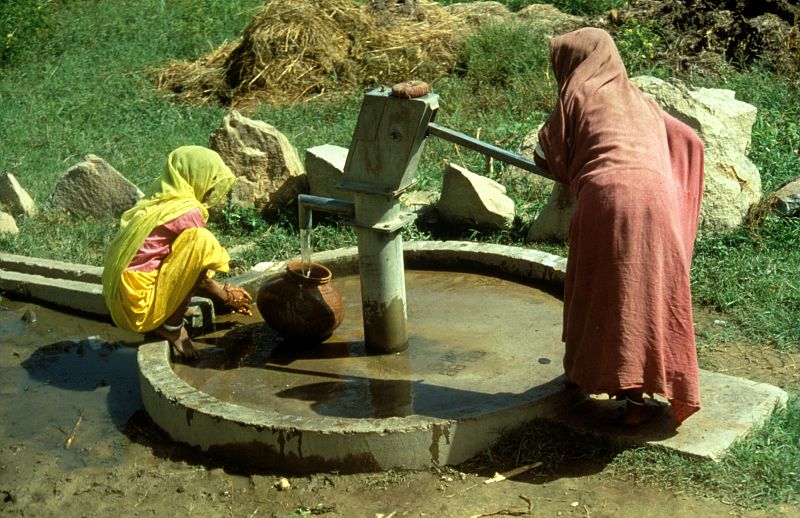Ressources dossier
Climate change and risksDoes agroecology hold the answers?
Published on 02 September 2022
How could agroecology help?
The global impact of the climate emergency requires a global system approach to change in agriculture and an end to farming’s current focus on productivity. The selection of species and breeds, crop management and our stewardship of the wider landscape must all come under scrutiny. We need to establish how to accomplish this transition, look at the timescale involved, given the urgency of the climate emergency, and reflect on how support can be provided to farmers, the lynchpins of the process.
Rethinking agriculture
Agroecology offers one possible way to reconcile the competing challenges that face agriculture. Providing a coherent framework that encompasses a variety of mechanisms, it requires a major change of approach – the ideal in farming is no longer to raise the highest-performing varieties or breeds under stable conditions and using synthetic inputs, instead, different varieties and species are farmed together, creating an agile system that can adapt to changing conditions. In the words of Thierry Caquet, Scientific Director of Environment at INRAE, "farmers may have to invest in training and share knowledge and machinery to achieve a successful agroecological transition, but changes must also be made along the entire food chain, which will have to invest in new machinery and equipment for harvesting, pick-up and processing that can cope with more mixed and varied products, create new sectors, and devise new ways of selling, etc. At the other end of the chain, there is also a key role for consumers, whose purchasing choices exert a powerful force for change right across the system. It’s the whole of society that has to move forward, not just farmers". To achieve this level of transformation, researchers are also exploring the role of the inclusive process of co-creation in building a novel agroecological system.
This area of the Institute’s work is made possible by its long-term monitoring relationships with farmers, its dedicated experimental facilities, and its ‘living lab’ projects, which provide showcases for change.
Quick wins for transition

In some cases, the speed of transition has been impressive. For example, following the abolition of milk quotas in April 2015 and the subsequent drop in prices, dairy farmers in the Aveyron switched to organic farming in just 2 years, some of them taking their herds from zero pasture regimes to seven months at pasture each year. The transition to grass was very quickly achieved. "The farmers immediately replanted their fields, electing to rely on the diversification of plant species (up to 10 species in some cases, with staggered planting cycles) to tide them over recurrent periods of drought. Good management of these meadows and of their grazing 1 enabled the farmers to reduce their costs, growing less maize for fodder and buying fewer fertilisers and concentrated feeds. These savings improved profitability from the very first year, even before the requisite period had been completed for their status as ‘organic farms’ to be approved, unlocking access to a sale price for organic milk that was one and a half times greater than conventionally-produced milk could command at the time", explains Guillaume Martin, an agronomist at INRAE, who tracked the progress of 19 dairy farmers over 3 years. His research also reveals that farmer satisfaction improved on conversion to organic production, especially that related to the economic viability of farmers’ businesses and their participation in social networks.
The shift to organic farming has also offered substantial advantages in terms of climate-change mitigation and adaptation. It has given the farmers greater flexibility in how they provide feed for their animals and has allowed them to take advantage of the capacity of grassland to store carbon, reduce erosion, increase biodiversity and improve the organic structure of the soil, which also improves its water retention. Last and not least, fresh grass supplies 90% of cattle’s water needs.
1. Species are selected to create perennial meadows and encourage regular grass growth, herds are returned to the field at the optimal moment to ‘clean away’ the old grass before spring growth begins, and grazing densities and durations are adjusted to encourage the re-growth of productive good-quality grass.
Long-term engagement from an entire sector
A number of levers can be used simultaneously by growers to adapt to the water deficiency affecting vineyards in the South of France
Transition is necessarily a far longer affair for perennial crops such as grapes and tree fruit, where growers have to plan 15 or even 30 years into the future. French wine growers have opted for concerted action, and the whole sector is involved in the adaptation and mitigation measures needed for its survival in a changing climate. It was the first sector to have acted on its undertakings and was able in 2021 to present a strategy to government based on the outcomes of the LACCAVE project (2012-2021), an INRAE initiative involving 35 research teams and 12 partner organisations. It identifies a number of levers that can be used simultaneously by growers to adapt to the water deficiency now affecting vineyards in the South of France, where estates are suffering from smaller harvests and changes in the quality of their grapes and wines. Actions include the selection of varieties and rootstocks with greater tolerance of drought, moving existing vines to deeper soils with more shade or at higher altitudes, and adjusting crop management (from pruning and leaf removal to the controlled use of cover crops, grass, straw, mulches, soil conditioning and hedge planting). Possibilities for future action include use of drip irrigation systems alongside agroecological practices and changes to vinification methods to reduce alcohol content.
Pioneering work in the vineyards
The sector is already adapting: "In the Bordeaux region, wine growers are trialling non-local varieties in response to climate change, while making sure that these conform to the typical profile of Bordeaux wines. Since 2018, the French wine registers have authorised the introduction of such varieties. At INRAE we are studying 52 different varieties from the South and West of Europe to establish how they would respond to the production conditions we expect in the Bordeaux region", says Nathalie Ollat, who jointly led the LACCAVE project with Jean-Marc Touzard, an INRAE economist. For the latter, the critical issue is the extent of the temperature rise. If growers implement all the measures explored in the project, he believes they should be able to adapt to a temperature rise that is still below two degrees centigrade in 2100. "But the higher we go above that threshold, the less likelihood there will be that the tradition of estate-based winegrowing that relies on the particular characteristics of a local area can continue. It is not just about temperature – unpredictable extreme weather patterns are going to make the sustainable production of high-quality wines in designated areas of origin increasingly hard to achieve. Instead, it is probable that more variable grape harvests will be sold to merchant-vintners who will be able to blend the wines and adjust them with chemicals. Year-round wine production could even be achieved by using musts from different regions. But if we love our wines and regional varieties, we need to do everything in our power to implement the COP21 objectives."
Conservation agriculture – does it use too much water?
The BAG’AGES project (2016-2021), coordinated by INRAE and supported by the Adour-Garonne Water Agency, monitored 11 agricultural parcels over a 3-year period, collecting data for modelling so an answer could be found to this critical question.
The carbon-storage capacity of soil offers a great opportunity to attenuate climate change, but we must also consider the implications for its function as a growing medium and precious water reservoir for plants. Soil-conservation agriculture is built on 3 pillars: a no-till approach, the diversification and extension of crop rotations, and the protection of soils from erosion through intercropping, where cover crops are sown between the harvest crops grown in rotation. But we need to understand how this system can impact water resources. Lionel Alletto and Olivier Therond, two of INRAE’s agronomists, have provided answers on two very different scales, looking both at the impact within a single agricultural parcel and at wider consequences for a whole region. Their work was greatly facilitated by the fact that, on 3 of the sites used in their trial, they were able to compare parcels managed on conservation-agriculture principles with conventionally worked parcels under identical soil and climate conditions.

When the same quantity of water is used, biomass yield is higher
Lionel Alletto: "At regional level, it can be hard to tell whether conservation agricultural systems are helping to save water because some farmers choose to irrigate their cover crops with the water they save by reducing the area of irrigated maize. Nevertheless, we can observe that, when the same volume of water is used, this system produces a biomass yield that is between 15% and 20% higher. Water efficiency has therefore been improved. We next need to look at what happens if the irrigation for the maize grown in these systems is gradually reduced. We are carrying out this work on our experimental sites because it is hard for farmers to take on the risk involved. More work is needed, too, on the selection of varieties with more tolerance of drought conditions.
The question remains, though, of why there is such a big gain in biomass density. First, we have demonstrated that the volume of water supplied to the plants is improved, with an observed rise of between 8 to 15% in the ‘useful supply’ available in these soils compared with traditionally worked soils. Water infiltration is improved in no-till soils despite their greater density because their pores are better networked as the result of earthworm activity and increased root growth – the roots penetrate more deeply into the ground because they are not obstructed by the compacted layer known as the ‘plough pan’. A further possible reason is that, when soils are kept covered and tilling is kept to a minimum, the plants are better nourished due to improved symbiotic relationships, particularly those involving mycorrhizae.
Water retention in soils is also helped by intercropping with cover crops since, although these do indeed consume water, they add organic matter to the soil once they have been destroyed, improving its water storage capacity. They also reduce water loss via surface flows, which means that there is less soil erosion. A last advantage of cover crops is their capacity to trap carbon. This has made them the lever of choice in the 4 per 1000 project for carbon storage in field crops. INRAE is currently investigating the use of a large variety of cover plants in both single and mixed sowings, including beans, vetch, forage radish, bristle or black oats, stubble turnips, rocket, and mustard."
Interplanted cover crops have no critical impact on flows in nearby watercourses
Olivier Therond: "The simulation model we use, Maelia, enables us to carry out a detailed analysis of the effects of cover crops and diversified rotations (maize, soya, sunflower, cereals, etc.), because of the many parameters it incorporates, including climate, soil, crop rotations, farming practices (sowing, irrigation), and the state of the water supply. The greatest concern over the practice of intercropping with cover crops has been the latter’s impact on the water supply, since the benefits of their ability to capture CO2 may be offset by their consumption of groundwater, with possible negative consequences for the performance of the subsequent crop, groundwater recharge levels and the replenishment of watercourses.
Our modelling has allayed this concern for the catchment in question, revealing that interplanted cover crops have no critical impact on either subsequent plantings or flows in nearby watercourses. Where soils are shallow or rainfall infrequent, the cover crops must simply be destroyed early enough for the soil water content to be replenished before the next crop emerges".
The key levers of agroecology
DIVERSIFICATION OF CROPS AND VARIETIES (and animal species and breeds)
To reduce vulnerability and reinforce resilience: use several cultivated varieties and species, alone or mixed; lengthen rotations; introduce legumes which provide the soil with nitrogen; introduce service plants, grown in association with cash crops or in intercropping for their beneficial effects (pest control, weeds, improving soil properties).
BIOCONTROL
Protecting crops with natural enemies of pests, biopesticides of plant origin and pheromones, rather than with synthetic pesticides.
ANIMAL-PLANT COMPLEMENTARITY
Associating crops and livestock to provide soil with organic matter and to make the best use of grasslands and crop by-products for animal feed (straw, oil cakes).
SOIL CONSERVATION
Covering soils to protect against erosion, store carbon, increase soil water reserves and provide organic matter.
ESTABLISHING AGROECOLOGICAL INFRASTRUCTURES
Hedges, grass strips, ditches and ponds to promote biodiversity (including beneficial insects) and water quality and limit run-off.
AGROFORESTRY
Plant trees to improve biodiversity, soil and water quality, provide shade and protection for animals and crops.
INTERNATIONAL: Working together to accelerate transition
The water problems associated with the climate emergency and agroecological transition must be addressed on a global scale, and INRAE both coordinates and contributes to numerous international projects.
The Institute is a driving force behind the European Joint Programme Initiative (JPI) water programme, launched in 2011 to coordinate the research activities of the 25 Member States on water management. INRAE is also a member of the REECAP network, working to promote the incorporation of experimental and behavioural approaches in creating the CAP assessment criteria. "We are working to develop tools and produce data that can guide policy makers and increase buy-in from farmers", says Sophie Thoyer, deputy head of INRAE’s EcoSocio Division.
Growth of interest in this approach is demonstrated by the award in January 2022 of the US CBEAR prize for agro-environmental innovation to the REECAP network. As Chatham House’s October 2021 report tells us, at a global level, the current lack of resilience in the agricultural sector, along with poverty and widespread inequalities in developing nations, particularly in Asia and Africa, is likely to exacerbate the impacts of climate change, causing them to cascade and amplify beyond national borders. The report concludes, therefore, that it is in wealthier nations’ interests to finance adaptation to climate change in regions most at risk 1.

With this in mind, since 2011, INRAE has been developing a research programme in partnership with India, a country that is, like all semi-arid zones, already living through the significant and early impacts of climate change. "The collaboration has been praised by the French Senate as an ‘exemplary partnership’. Using the tools provided by experimental economics and modelling, we are working with our Indian colleagues to explore properly-costed adaptation strategies based on locally-conducted research. Given this major environmental challenge, our mission both in France and internationally is to provide support for transformation through research and assistance to government policy-makers that can take us down new and more sustainable pathways", concludes Alban Thomas, Deputy Scientific Director of Environment at INRAE.
1. What near-term climate impacts should worry us most? Quiggin et al., Oct 2021, Environment and Society Programme.
- Pascale Mollier / translated by Teresa Bridgeman
-
Thierry Caquet
INRAE Scientific Director of Environment
- Guillaume Martin, Lionel Alletto AGIR Joint Research Unit
- Nathalie Ollat EGFV Joint Research Unit
- Jean-Marc Touzard INNOVATION Joint Research Unit
- Olivier Thérond LAE-Colmar Joint Research Unit
-
Sophie Thoyer
Deputy Head, ECOSOCIO division
CEE-M Joint Research Unit -
Alban Thomas
Deputy Scientific Director of Environment
Paris-Saclay Applied Economics
